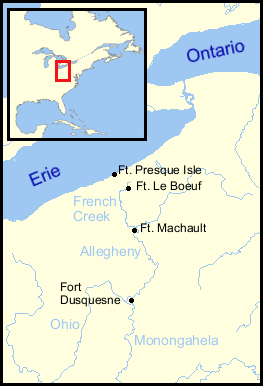Fort Le Boeuf facts for kids
Quick facts for kids Fort Le Boeuf |
|
|---|---|
| Waterford, Pennsylvania, USA | |

Fort Le Boeuf during 1754.
|
|
| Coordinates | 41°56′22″N 79°58′57″W / 41.939510°N 79.982452°W |
| Site information | |
| Controlled by | |
| Site history | |
| Built | 1753 |
| In use | 1753–1763 |
| Demolished | 1763-06-18 |
| Battles/wars | French and Indian War Pontiac's Rebellion |
| Garrison information | |
| Past commanders |
Jacques Legardeur de Saint-Pierre |
Fort Le Boeuf was an important fort built by the French in 1753. It was located on a branch of French Creek in what is now Waterford, in northwest Pennsylvania. The fort was named after LeBoeuf Creek, which was nearby.
This fort was part of a chain of forts. These included Fort Presque Isle, Fort Machault, and Fort Duquesne. The French used Fort Le Boeuf to move supplies and trade goods. They brought items overland from Lake Erie to the fort. From there, they traveled by raft and canoe down French Creek. This route led to the Allegheny, Ohio, and Mississippi rivers.
Today, the place where the fort stood is home to the Fort LeBoeuf Museum. The Fort LeBoeuf Historical Society runs this museum.
Building Fort Le Boeuf
The French started building Fort Le Boeuf on July 11, 1753. Captain Paul Marin de la Malgue led the construction. Later, Jacques Legardeur de Saint-Pierre took command on December 3, 1753.
This fort was the second in a series of posts built by the French. They built these forts between 1753 and 1754. Their goal was to claim the Ohio Country. The four forts—Fort Presque Isle, Fort Le Boeuf, Fort Machault, and Fort Duquesne—stretched from Lake Erie to the Forks of the Ohio River. These forts were the last part of France's plan. They wanted to connect their lands in Canada with their lands in the Illinois Country and Louisiana.
The French also took over an English trading post. This post belonged to John Frazier and was located at Venango. After setting up these new forts, the French leaders returned to Canada for the winter. Fort Le Boeuf was important because it guarded the southern end of a portage road. This road connected Lake Erie to French Creek. The fort served as a French trading post and a military base. The French held it until 1759. At that time, they lost Fort Niagara, which forced them to leave the Ohio Country.
George Washington's Visit
In 1753, Robert Dinwiddie, the governor of Virginia, sent a young man named George Washington to Fort Le Boeuf. Washington was only 21 years old. He went with seven escorts to deliver a message to the French. The message demanded that the French leave the Ohio Country. Governor Dinwiddie sent Washington because the French were building forts in the area.
Washington brought Christopher Gist as his guide. During their journey, Gist saved Washington's life twice! They arrived at Fort Le Boeuf on December 11, 1753. Jacques Legardeur de Saint-Pierre, the fort's commander, was an experienced soldier. He welcomed Washington politely. However, he refused Washington's demand that the French leave.
Saint-Pierre offered Washington three days of hospitality at the fort. Then, he gave Washington a letter to take back to Governor Dinwiddie. The letter told the Governor of Virginia to send his demands to the Major General of New France in Quebec City.
While he was there, Washington observed the fort closely. He noted that it had 100 men and many officers. There were also 50 birch canoes and 70 pine canoes, some still being built. He described the fort as being on a branch of French Creek. It was near the water and almost surrounded by it. Four houses formed the sides of the fort. The walls, called bastions, were made of logs driven into the ground. They stood over 12 feet high and were sharpened at the top. There were openings for cannons and small guns. Each bastion had eight six-pound cannons. One four-pound cannon guarded the main gate. Inside the fort, there was a guard-house, a chapel, a doctor's room, and the commander's storage area. Outside the fort, there were several log barracks, stables, a blacksmith's shop, and other buildings.
Wars and Changes
The French and Indian War officially began on May 28, 1754. This was with the Battle of Jumonville Glen. About five years later, on July 25, 1759, the French surrendered Fort Niagara. In August 1759, the commander of Fort Presque Isle ordered Fort Machault and Fort Le Boeuf to be abandoned. After the French left, the British took control of these sites. It is not clear if the French burned Fort Le Boeuf when they left. If they did, the British rebuilt it.
Pontiac's Rebellion
During Pontiac's Rebellion, on June 18, 1763, a group of Native Americans attacked and burned Fort Le Boeuf. The people who survived escaped to Fort Venango. However, Fort Venango was also burned. So, they continued their journey to Fort Pitt.
In 1794, Major Ebenezer Denny reported on the fort to Governor Thomas Mifflin. He described a fort with four blockhouses. These were manned by riflemen. The two back blockhouses had a six-pound cannon on the second floor. They also had swivel guns above the gates.
When Judge Vincent settled in Waterford in 1797, he wrote about the fort. He said, "There are no remains of the old French fort excepting the traces on the ground..." This means only outlines of the fort could be seen.


